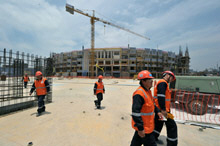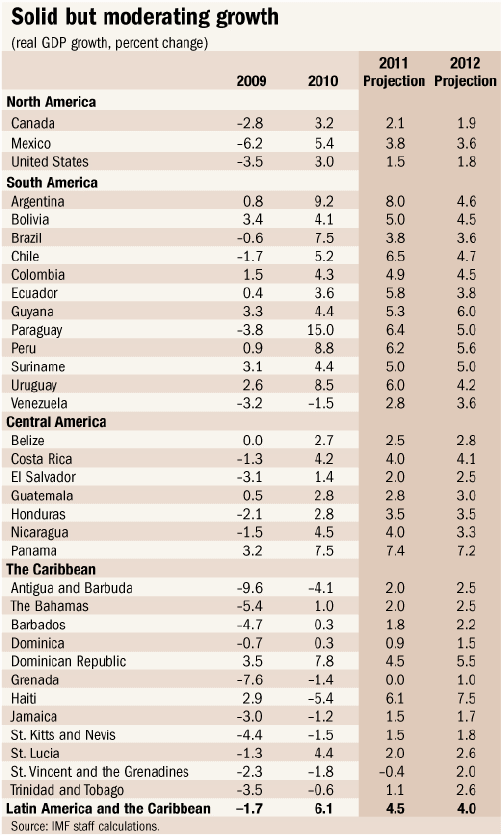
Typical street scene in Santa Ana, El Salvador. (Photo: iStock)
IMF Survey: Latin America: Solid Growth But Risks Grow
October 5, 2011
- 4½ growth predicted for Latin America in 2011
- But large risks to the outlook remain
- Need to rebuild buffers, with monetary policy nimble
Latin America and the Caribbean is expected to expand by 4½ percent in 2011 and to moderate to about 4 percent in 2012. Although the slowdown in advanced economies is projected to have only a moderate effect in most countries, large risks to the outlook loom, the IMF said.

Construction workers remodeling the National Stadium in Lima, Peru. Growth in Latin America has so far held up well (photo: Chris Bouroncle/Newscom)
Regional Economic Outlook
In its Regional Economic Outlook for the region, issued on October 5 in Lima, Peru, the IMF said countries in the region continue to benefit from double tailwinds of easy external financing conditions and still-high commodity prices, although these factors are projected to be less stimulative than before.
So far in 2011, economic activity has moderated from the high levels reached in 2010, but remains above potential in much of the region. Growth has been driven by strong domestic demand, with the commodity-exporting countries of South America leading the way.
More recently, fears of a global slowdown are starting to weigh in on the region’s financial markets, with equities, currencies, and commodities taking a hit.
“We still have as our baseline a situation in which both global liquidity and commodity prices will remain, as we have called them, the double tailwinds for the region,” said Nicolás Eyzaguirre, Director of the IMF’s Western Hemisphere Department. “However, these will be somewhat weaker than in the recent past,” he added. Also, with the fluid situation in the markets, the report notes that downside risks are potentially severe.
Large risks dominate the outlook
The lack of a decisive solution to the closely linked sovereign and bank balance sheet stresses in Europe could worsen confidence and global credit markets conditions, with spillovers to emerging markets. Similarly, in the United States a too front-loaded fiscal adjustment could weaken growth, while an insufficient fiscal adjustment over the medium term could weaken confidence and result in higher interest rates down the road.
Meanwhile, a sharp slowdown in Asia—for example, triggered by an advanced economy recession—could further hit commodity prices, with negative effects on Latin American commodity exporters, the report said.
On the upside, a quick resolution of European stresses and a better outlook for global growth could reignite strong capital inflows, bringing back overheating risks.
Rebuilding buffers
This shift in the global economic environment poses major challenges to policymakers. According to the report, Latin America and the Caribbean should generally stay their present policy course, including maintaining a nimble monetary stance and rebuilding fiscal buffers—but stand ready to shift course should the risks noted above materialize.
In South American countries with more robust growth, overheating dangers have lessened but not disappeared, the report said. Nevertheless, where monetary policy frameworks are credible and inflation expectations are well anchored, monetary tightening could pause for now. Easing should be the first line of defense should the global outlook deteriorate further.
Meanwhile, gradual fiscal consolidation should continue as planned in these countries to avoid hurting fiscal credibility and create room for maneuver should the large downside risks to growth materialize. In addition, the report noted that macroprudential policies should remain part of the policy toolkit to protect the stability of the banking system.
Countries with strong real linkages to the United States, like Mexico and much of Central America, face a somewhat weaker outlook. The report urges these countries to bring public debt down to precrisis levels, with monetary policy playing a more active role in managing the cycle in countries with credible inflation frameworks.
In the Caribbean, greater resolve is required in bringing down high public debt levels and decisively addressing persistent weaknesses in the financial sector.
The threat of a sharp fall in commodity prices
Latin America is as dependent on commodities today as it was 40 years ago. With commodity prices quite sensitive to global output, the region is particularly vulnerable to a global economic slowdown.
However, as Chapter 3 of the outlook reports, policies can play an important role in mitigating the economic impact of these shocks. Countries with strong policies—exchange rate flexibility if dollarization is low along with sound external and fiscal positions—particularly during the boom phase of the commodity price cycles, fare better. This highlights the need to rebuild policy buffers to allow the region to be better placed to withstand a commodity price turnaround.
The Regional Economic Outlook for the Western Hemisphere is being released with events in Lima, Peru (October 5), Bridgetown, Barbados (October 10), and Montevideo, Uruguay (November 3).



